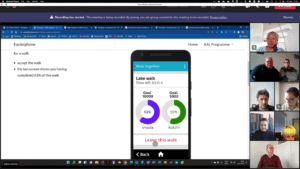Co-creation workshop - discussing new features

Internos develop and test, together with partners, an application to simplify the use of smartphones. Who has not searched for a long time for that one app on their smartphone that is somewhere between all those other dozens? Easierphone simplifies the home screen and lists the most used apps in a simple way. It is also developing an assistant function, so that someone else (partner/carer) can, after permission, help the user to set up and adjust this simplified start screen.
Recently Internos organised a workshop with members of its client council to brainstorm about additional features of Easierphone. Three new modules will be added in the next test:
- Walk together; where you can make walking appointments with others and compare the number of steps you take
- One touch call; allowing immediate contact with pre-selected people
- Activity trends; looking at the development in the degree of use of the telephone and movement outside
It was a lively discussion with good tips from the Internos client board members for the developers of Easierphone. One of the key findings was that following and monitoring a user was sometimes considered useful, but not always. However, when it comes to assisting vulnerable people using Easierphone, it can be useful for the assistant to see how a user’s activity pattern develops. For example, if someone regularly wanders or shows much reduced activity, this may be a signal for the assistant to intervene.


Navigating the Digital World: A Step-by-Step Guide for Seniors
In today's digital age, technology has become an integral part of our daily lives. Whether it's connecting with loved ones, shopping, or accessing vital information, digital skills are more important than ever. If you're a senior looking to improve your digital skills, fear not; this step-by-step guide is here to help you embark on your digital journey with confidence.

Step 1: Embrace a Positive Mindset
The first step to becoming digitally savvy is adopting a positive mindset. Understand that it's okay to start from scratch and that learning takes time. Approach this journey with curiosity and a willingness to explore new things.
Step 2: Choose the Right Device
Select a device that suits your needs and preferences. Common choices include smartphones, tablets, and computers. Consider factors like screen size, ease of use, and portability.
Step 3: Get Comfortable with Basics
Before diving into advanced skills, start with the basics:
- Turning Your Device On and Off: Familiarize yourself with the power button.
- Navigating the Home Screen: Learn to access different apps and functions.
- Texting and Calling: Practice sending text messages and making calls.
Step 4: Connect to the Internet
To access the digital world, you'll need an internet connection. If you have Wi-Fi at home, learn how to connect your device to it. If not, explore affordable data plans from your service provider.
Step 5: Master Email Basics
Email is an essential communication tool. Set up an email account and practice sending and receiving messages. Learn how to attach files and photos.
Step 6: Explore Search Engines
Search engines like Google can help you find information online. Practice searching for topics of interest and navigating the search results.
Step 7: Embrace Social Media
Social media platforms like Facebook and Instagram can help you stay connected with friends and family. Create an account and learn how to post, comment, and share.
Step 8: Online Safety
Protecting your online privacy and security is crucial. Learn about strong password practices, recognize phishing attempts, and be cautious about sharing personal information.
Step 9: Digital Assistance
Voice-activated virtual assistants like Siri (Apple), Google Assistant (Android), and Alexa (Amazon) can simplify tasks. Ask them questions, set reminders, or even control smart devices in your home.
Step 10: Explore Apps
Discover useful apps tailored to your interests. Whether it's reading news, tracking health, or playing games, there's an app for almost everything. Download and explore them.
Step 11: Take Online Courses
Many online platforms offer free or affordable courses on digital literacy. Websites like Coursera, edX, and Khan Academy are excellent resources to enhance your skills.
Step 12: Seek Help and Support
Don't hesitate to ask for help when needed. Family members, friends, or local community centers can provide guidance and support. Consider joining local senior tech groups or workshops.
Step 13: Practice, Practice, Practice
The more you practice, the more confident you'll become. Regularly use your device for various tasks to reinforce your digital skills.
Step 14: Stay Informed
Stay up-to-date with technology trends and updates. Technology is constantly evolving, so continue learning and adapting.
Step 15: Share Your Knowledge
Once you've gained confidence in your digital skills, share your knowledge with others. Offer to help fellow seniors who may be starting their own digital journeys.
Remember, improving your digital skills is a journey, not a destination. Take one step at a time, be patient with yourself, and enjoy the newfound opportunities that technology brings to your life. Whether you're connecting with loved ones, exploring new hobbies, or accessing valuable information, your digital journey is bound to be an enriching experience. Happy digital learning!
